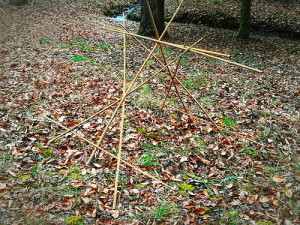 This is more of a “proof-of-concept” project but it could prove to be valid in an emergency situation where a shelter structure could be made without cordage or other binding material. The main function of a reciprocal structure is that inter-woven elements such as poles, sticks, or branches are kept in place via pressure or tension by adjacent poles, sticks, or branches that are “woven” together.
This is more of a “proof-of-concept” project but it could prove to be valid in an emergency situation where a shelter structure could be made without cordage or other binding material. The main function of a reciprocal structure is that inter-woven elements such as poles, sticks, or branches are kept in place via pressure or tension by adjacent poles, sticks, or branches that are “woven” together.
These poles, perhaps an inch in diameter, should be stiff with a slight ability to flex so that when combined with other poles will create a woven framework. Unlike a woven basket that uses very flexible vines or reed-like branches, the finished pole structure might more visibly resemble a panel or flat frame.
I happened to have some bamboo poles so I decided to try out this method of an interlaced structure. The bamboo has a very smooth surface and was very slippery but it did work as shown in the photo. The stability of poles used in this way could be enhanced by making notches where the two parts cross. Additional sticks could be added like a conventional debris hut or teepee to provide insulation to the frame. It helps to align the bottom ends on the ground to settle each side and could be stabilized even further by pressing each pole into the ground like a stake.
There are so many ways to make cordage that would make this a more stable structure but it’s good to know alternative methods when your resources may be limited.


